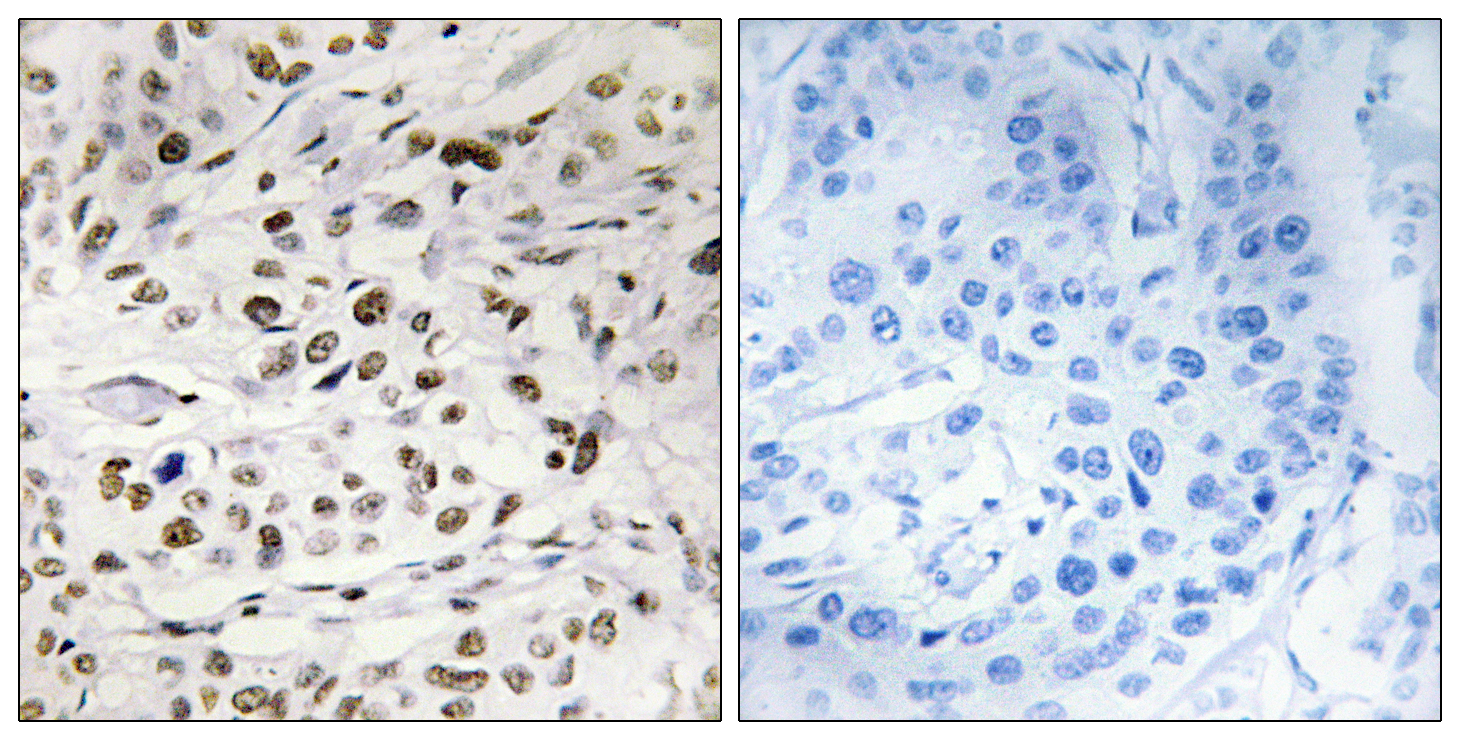HMG-14 (phospho Ser21) Polyclonal Antibody
- Catalog No.:YP1153
- Applications:IHC;IF;ELISA
- Reactivity:Human;Mouse;Rat
- Target:
- HMG-14
- Gene Name:
- HMGN1
- Protein Name:
- Non-histone chromosomal protein HMG-14
- Human Gene Id:
- 3150
- Human Swiss Prot No:
- P05114
- Mouse Gene Id:
- 1.00044e+008
- Mouse Swiss Prot No:
- P18608
- Immunogen:
- The antiserum was produced against synthesized peptide derived from human HMG14 around the phosphorylation site of Ser21. AA range:10-59
- Specificity:
- Phospho-HMG-14 (S21) Polyclonal Antibody detects endogenous levels of HMG-14 protein only when phosphorylated at S21.
- Formulation:
- Liquid in PBS containing 50% glycerol, 0.5% BSA and 0.02% sodium azide.
- Source:
- Polyclonal, Rabbit,IgG
- Dilution:
- IHC 1:100 - 1:300. IF 1:200 - 1:1000. ELISA: 1:10000. Not yet tested in other applications.
- Purification:
- The antibody was affinity-purified from rabbit antiserum by affinity-chromatography using epitope-specific immunogen.
- Concentration:
- 1 mg/ml
- Storage Stability:
- -15°C to -25°C/1 year(Do not lower than -25°C)
- Other Name:
- HMGN1;HMG14;Non-histone chromosomal protein HMG-14;High mobility group nucleosome-binding domain-containing protein 1
- Molecular Weight(Da):
- 11kD
- Background:
- The protein encoded by this gene binds nucleosomal DNA and is associated with transcriptionally active chromatin. Along with a similar protein, HMG17, the encoded protein may help maintain an open chromatin configuration around transcribable genes. [provided by RefSeq, Aug 2011],
- Function:
- function:Binds to the inner side of the nucleosomal DNA thus altering the interaction between the DNA and the histone octamer. May be involved in the process which maintains transcribable genes in an unique chromatin conformation. Inhibits the phosphorylation of nucleosomal histones H3 and H2A by RPS6KA5/MSK1 and RPS6KA3/RSK2.,mass spectrometry: PubMed:10739259,PTM:Phosphorylation on Ser-21 and Ser-25 weakens binding to nucleosomes and increases the rate of H3 phosphorylation (By similarity). Phosphorylation favors cytoplasmic localization.,RNA editing:Partially edited. A new initiator methionine may be created by a single uridine insertion in the 5'-UTR, causing an N-terminal extension of 45 amino acids. The existence of the RNA edited version is supported by direct protein sequencing by MS/MS of the following peptides specific to that version: 23-31 and 40-48. The RNA edited version is
- Subcellular Location:
- Nucleus. Cytoplasm. Cytoplasmic enrichment upon phosphorylation. The RNA edited version localizes to the nucleus.
- Expression:
- Bone marrow,Brain,Epithelium,Liver,Ovary,Pooled,Skin,
- June 19-2018
- WESTERN IMMUNOBLOTTING PROTOCOL
- June 19-2018
- IMMUNOHISTOCHEMISTRY-PARAFFIN PROTOCOL
- June 19-2018
- IMMUNOFLUORESCENCE PROTOCOL
- September 08-2020
- FLOW-CYTOMEYRT-PROTOCOL
- May 20-2022
- Cell-Based ELISA│解您多样本WB检测之困扰
- July 13-2018
- CELL-BASED-ELISA-PROTOCOL-FOR-ACETYL-PROTEIN
- July 13-2018
- CELL-BASED-ELISA-PROTOCOL-FOR-PHOSPHO-PROTEIN
- July 13-2018
- Antibody-FAQs
- Products Images

- Immunohistochemical analysis of paraffin-embedded Human brain. Antibody was diluted at 1:100(4° overnight). High-pressure and temperature Tris-EDTA,pH8.0 was used for antigen retrieval. Negetive contrl (right) obtaned from antibody was pre-absorbed by immunogen peptide.

- Enzyme-Linked Immunosorbent Assay (Phospho-ELISA) for Immunogen Phosphopeptide (Phospho-left) and Non-Phosphopeptide (Phospho-right), using HMG14 (Phospho-Ser21) Antibody

- Immunofluorescence analysis of COS7 cells, using HMG14 (Phospho-Ser21) Antibody. The picture on the right is blocked with the phospho peptide.

- Immunohistochemistry analysis of paraffin-embedded human breast carcinoma, using HMG14 (Phospho-Ser21) Antibody. The picture on the right is blocked with the phospho peptide.



